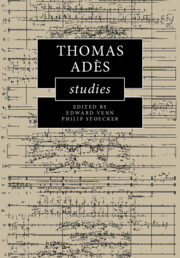Book contents
- Thomas Adès Studies
- Thomas Adès Studies
- Copyright page
- Dedication
- Contents
- Figures
- Tables
- Music Examples
- Online Materials
- Contributors
- Preface
- Acknowledgements
- Notes on the Text
- 1 ‘Chronically volatile’
- 2 Performing Adès
- 3 ‘Fountain of Youth’, ‘River of Meaning’
- 4 ‘Oh brave new Caliban’
- 5 Chaconnes in the Music of Adès
- 6 Closing the Circle?
- 7 A World in Constant Motion
- 8 Musique automatique? Adèsian Automata and the Logic of Disjuncture
- 9 Narrating the Dance of Death
- 10 Hearing Voices in Adès’s Operas
- 11 The RICH Logic of Adès’s The Exterminating Angel and The Tempest
- 12 Sonic Allegory in Adès’s The Exterminating Angel
- Bibliography
- Index
6 - Closing the Circle?
Tevot and the Question of Symphonic Resolution
Published online by Cambridge University Press: 18 November 2021
- Thomas Adès Studies
- Thomas Adès Studies
- Copyright page
- Dedication
- Contents
- Figures
- Tables
- Music Examples
- Online Materials
- Contributors
- Preface
- Acknowledgements
- Notes on the Text
- 1 ‘Chronically volatile’
- 2 Performing Adès
- 3 ‘Fountain of Youth’, ‘River of Meaning’
- 4 ‘Oh brave new Caliban’
- 5 Chaconnes in the Music of Adès
- 6 Closing the Circle?
- 7 A World in Constant Motion
- 8 Musique automatique? Adèsian Automata and the Logic of Disjuncture
- 9 Narrating the Dance of Death
- 10 Hearing Voices in Adès’s Operas
- 11 The RICH Logic of Adès’s The Exterminating Angel and The Tempest
- 12 Sonic Allegory in Adès’s The Exterminating Angel
- Bibliography
- Index
Summary
Thomas Adès has mused on symphonic form in terms of logic and resolution – as ‘something which closes a circle’. Nevertheless, his interest in the symphonies of Jean Sibelius is sparked by their resistance to this trend; the one-movement Seventh Symphony, in particular, is a work he hears as ‘painfully inconclusive’. This contradiction plays out in Adès’s own one-movement symphony, Tevot (2007). In both works, audible developments are underpinned by a carefully managed network of tempos. Recurring sonorities not only delineate this structure but also prompt perceptual shifts, underlining forms that are at once stable and volatile, recurrent and changing, static and dynamic, closed and open. In this chapter, the Seventh Symphony offers a potent lens through which Tevot can be viewed, shedding light not only upon Adès’s navigation of symphonic resolution, but also upon the way in which he – like Sibelius – engages with symphonic traditions at large.
- Type
- Chapter
- Information
- Thomas Adès Studies , pp. 117 - 137Publisher: Cambridge University PressPrint publication year: 2021

